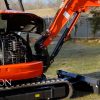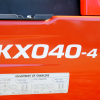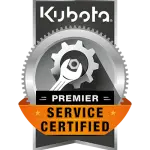Your compact tractor is a significant investment that will last a long time with careful maintenance. Your owner or operator manual will have instructions and a detailed tractor maintenance schedule for your specific model, but there are some simple checks that apply to any type of tractor.
To make this checklist effective, add specific information from your operator manual, such as optimal tire pressure, oil and fluid capacity, and location of zerk fittings.
- Inspect the tires. Check tire pressure and look for signs of wear, damage, or leaks. Tires that are improperly inflated will wear faster.
- Look for signs of oil or water leaks from your tractor or its hydraulic system. Start by looking for evidence of leaks on the ground under the equipment, then check the hoses. Dirt buildup on a hose or fitting could indicate a small leak. Clean the hose and do a visual inspection for wear and fit. You can save money and down time by tightening fittings or replacing worn hoses before they become a major problem.
- Check your fluids: Engine and transmission oil, hydraulic fluids, radiator and recovery tank coolants. Over time, any compact tractor engine with lose a small amount of fluids, and you can expect to top the fluids off now and then. If your tractor starts losing an unusual amount of fluids, you most likely have a leak, which can be serious.
- Grease the joints. Look for the small metal fittings for inserting grease into mechanical joints, called zerks. When you’re checking the manual to fill out information on your compact tractor maintenance checklist, make note of the location of each zerk, to make sure you get all of them.
- Check the tractor body for damage. Test bolts, nuts, and pins, tightening as necessary. Dings to the body may be cosmetic, or may rub against the tires or prevent implements for working properly. Assess any damage before starting work. Also check implements, ROPS, and accessory blades for wear and damage.
- Check the belts for signs of wear and verify the tension. Change the belt if you see signs of slippage or damage.
- Clean the radiator screen and core, panel and hood screens, air cleaner primary element. When cleaning, be careful not to damage the radiator or condenser fins. Use condensed air for fine cleaning, and a low-pressure hose for larger areas.
- Check parking brakes, levers, safety switches, hazard lights, and turn indicators to make sure everything is in good working order. Make sure safety features like PTO shields are in place and that the neutral start switch is operating correctly.
- Fill ‘er up. Start your day with a full fuel tank. If your tank gets near empty, drain the remaining fuel to check for sediments before filling with fresh fuel. If you store your fuel in metal cans, make sure they are clean, sealed, and rust-free before using stored gas. If air can get in, so can water. Don’t store or use gas stored for more than three months. Additives sold by most major manufacturers will help keep your gas ready for use. It’s best to use products made by your manufacturer – John Deere oil and additives are made specifically for John Deere tractors and Kubota products are made for Kubota tractors.
- Start ‘er up. Before taking off, take a moment to listen for abnormal noise or vibrations, and watch the engine emissions. Blue smoke in the exhaust or reduced power may indicate an internal oil leak.
In addition to your daily checks, your tractor requires regular maintenance on schedule, usually determined by hours of use. Owners who don’t use their tractors often choose to do scheduled maintenance once a year even if they haven’t met the number of hours.
Resources:









